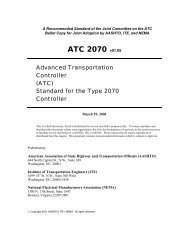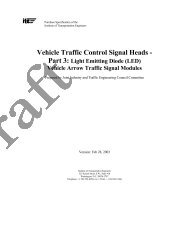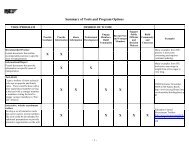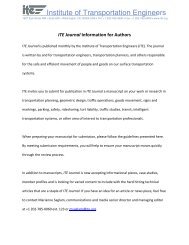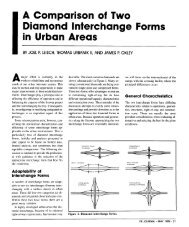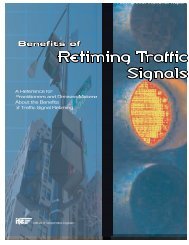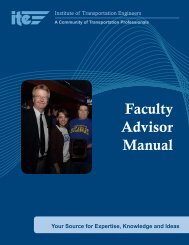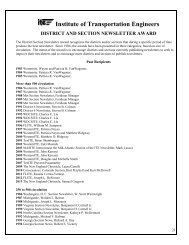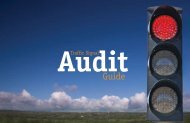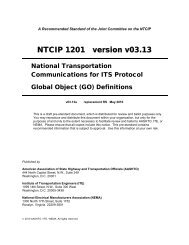Parking Generation Update: The Numbers - Institute of ...
Parking Generation Update: The Numbers - Institute of ...
Parking Generation Update: The Numbers - Institute of ...
You also want an ePaper? Increase the reach of your titles
YUMPU automatically turns print PDFs into web optimized ePapers that Google loves.
<strong>Parking</strong> <strong>Generation</strong> <strong>Update</strong>: <strong>The</strong> <strong>Numbers</strong><br />
Ransford S. McCourt, PE, PTOE<br />
Principal, DKS Associates<br />
<strong>The</strong> <strong>Institute</strong> <strong>of</strong> Transportation Engineers (ITE) Transportation Planning Council decided<br />
to actively pursue updating the <strong>Parking</strong> <strong>Generation</strong> Informational Report in 1999. In the<br />
following three years, the historic parking demand survey records were converted to<br />
current spreadsheets formats to preserve the data for future use and nearly four times<br />
more data was obtained through various sources to enrich the available information on<br />
parking demand. <strong>The</strong> third edition <strong>of</strong> the <strong>Parking</strong> <strong>Generation</strong> Informational Report<br />
represents a substantial change from the second edition published in 1987, providing the<br />
pr<strong>of</strong>ession a new tool to better understand the relationship between land use and parking<br />
demand.<br />
Since the decision to update <strong>Parking</strong> <strong>Generation</strong>, ITE has formed the <strong>Parking</strong> Council<br />
that will become responsible for future updates to the informational report and managing<br />
the data acquisition. It is anticipated that publication <strong>of</strong> the updated <strong>Parking</strong> <strong>Generation</strong><br />
will reinvigorate interest in parking demand stimulating significant new data for further<br />
updates to the informational report.<br />
Several new user features have been added to summarize data and statistical information<br />
<strong>of</strong> the surveys submitted. In the first two editions <strong>of</strong> <strong>Parking</strong> <strong>Generation</strong>, emphasis was<br />
placed on averaging the maximum observed parking demand primarily from isolated,<br />
suburban sites to obtain parking demand ratios. This update begins a process <strong>of</strong><br />
segregating parking data records for future analysis and research into various factors that<br />
may affect parking demand. <strong>Parking</strong> data is linked to the hour <strong>of</strong> observation to provide<br />
a temporal understanding <strong>of</strong> parking demand and the peak hour <strong>of</strong> parking demand.<br />
Additionally, this update separates out the influences <strong>of</strong> area type on parking demand,<br />
including (where data is available) information about sites that have priced parking.<br />
This update only begins to explore the variations in parking demand based upon these<br />
other factors. Much <strong>of</strong><br />
data currently available is<br />
from unpriced, suburban<br />
sites with isolated single<br />
land uses. As future<br />
studies are submitted, they<br />
will provide a basis to<br />
assess factors such as type<br />
<strong>of</strong> area, pricing, transit<br />
availability/quality,<br />
transportation demand<br />
management plans, mixing<br />
<strong>of</strong> land uses, pedestrian<br />
friendly design, land use<br />
density, trip
chaining/multi-stop trip activity, employee/visitor parking, long term/short term parking<br />
and other issues in more detail. Where information <strong>of</strong> this type was available, it has been<br />
reported; however, at this time the extent <strong>of</strong> data in this area is limited.<br />
More parking data is needed to understand the complex nature <strong>of</strong> parking demand. This<br />
informational report does not provide authoritative findings, recommendations or<br />
standards on parking demand. It should be understood that assemblage <strong>of</strong> data and<br />
production <strong>of</strong> this report are a fully-volunteer effort and not the result <strong>of</strong> a financed<br />
research effort. As such, the report contains useful parking demand data – ranges <strong>of</strong><br />
information and statistics are provided only as an informational guide to planners and<br />
designers regarding parking demand.<br />
<strong>The</strong>re is a tendency to focus on a single number (such as the average) to form the basis<br />
for estimating parking demand. Care should be utilized in applying the information<br />
presented in this informational report to estimate parking demand, reflecting upon ranges<br />
<strong>of</strong> demand, statistical quality and quantity. Information (where available) regarding other<br />
factors (such as transportation demand management, area type, pricing and several<br />
others) is also provided.<br />
Because <strong>of</strong> the cost <strong>of</strong> providing parking, it would be appropriate to seek guidance from<br />
parking pr<strong>of</strong>essionals with experience in understanding the many variables that can affect<br />
parking demand rather than simply utilizing a single number from this informational<br />
report.<br />
Objective<br />
To build a comprehensive understanding <strong>of</strong> parking<br />
demand characteristics <strong>of</strong> various land uses by<br />
providing a process to easily expand the parking<br />
demand data set, continually updating information<br />
and reaching as many potential users, researchers<br />
and pr<strong>of</strong>essionals as possible.<br />
Organization <strong>of</strong> Report<br />
<strong>The</strong> <strong>Parking</strong> <strong>Generation</strong> Informational Report<br />
provides the following sections:<br />
• Use <strong>of</strong> the <strong>Parking</strong> <strong>Generation</strong> Report<br />
This section outlines how to use information<br />
in this report answering basic questions<br />
such as “What is an Informational Report”<br />
• Data Analysis<br />
This section outlines the statistics that have been utilized and the basic guidelines<br />
for defining the quality <strong>of</strong> data as well as the quantity <strong>of</strong> data
• Definitions<br />
This section provides a glossary <strong>of</strong> terms utilized in this report, particularly<br />
related to independent variables and statistics.<br />
• Format <strong>of</strong> Data Provided for Each Land Use<br />
This two page summary outlines how the data for each land use code is organized<br />
and where to find key information.<br />
• <strong>Parking</strong> Data by Land Use Code<br />
This is the core data for <strong>Parking</strong> <strong>Generation</strong> organized by ITE Land Use Code<br />
(over 100 land uses are described).<br />
• Summary <strong>of</strong> <strong>Parking</strong> Data (Appendix A)<br />
<strong>The</strong>se tables provide a quick reference guide to the parking data, collapsing<br />
hundreds <strong>of</strong> pages <strong>of</strong> data into a few summary sheets.<br />
• <strong>Parking</strong> Data Sources (Appendix B)<br />
This section provides the sources <strong>of</strong> each parking survey utilized in this report,<br />
indicating the name <strong>of</strong> the data provider, location (city) <strong>of</strong> their survey and the<br />
month/year <strong>of</strong> the survey.<br />
• Mixed-Use <strong>Parking</strong> Data (Appendix C)<br />
This section summarizes a limited number <strong>of</strong> surveys submitted to ITE for mixedland<br />
use sites. While little statistical data is provided, these surveys provide<br />
analysts with parking demand case studies to compare shared parking<br />
calculations with reality.<br />
• Data Collection Techniques (Appendix D)<br />
This section provides<br />
information on how to collect<br />
parking demand information,<br />
how parking data contained in<br />
this report was obtained and<br />
resources such as the parking<br />
demand data collection form.<br />
It also outlines the <strong>Parking</strong><br />
<strong>Generation</strong> Committee’s<br />
recommended areas for<br />
additional parking demand<br />
surveys and suggests some<br />
approaches that local ITE<br />
Chapters, Sections or Districts<br />
may employ to increase the<br />
quantity and quality <strong>of</strong> data.
<strong>Update</strong> Process<br />
<strong>The</strong> current process to update <strong>Parking</strong> <strong>Generation</strong> began in Las Vegas in 1999 at the ITE<br />
Annual Meeting. Over the next 18 months, all <strong>of</strong> the historical data records from ITE<br />
were entered into spreadsheets as a data base and other data sources were contacted.<br />
Following <strong>Parking</strong> <strong>Generation</strong> Committee meetings in Nashville (00), Monterey (01),<br />
Chicago (01) and Philadelphia (02) – open houses were conducted, presentations (nearly<br />
a dozen) were made to pr<strong>of</strong>essionals and substantial emailing <strong>of</strong> ITE members was<br />
undertaken. At these meetings, presentations and open houses – issues such as the<br />
format, preliminary data, type <strong>of</strong> information, statistics, means to obtain data and text<br />
were reviewed.<br />
<strong>The</strong> ITE web site has been used to announce the update activities in 2001, opening a<br />
communication link with the pr<strong>of</strong>ession. Newsletters (Traffic Council, Transportation<br />
Planning Council, <strong>Parking</strong> Council, WesternITE, section news) were used to request<br />
volunteer support and data. Searches on the internet were conducted to determine where<br />
additional existing parking demand data may exist; followed by individual contact.<br />
Beyond this, numerous ITE members and parking associations were notified via<br />
email/mail <strong>of</strong> the update process and were requested to contribute any parking data they<br />
might have available. Comments provided by member (including member surveys)<br />
provided insights into the user features that pr<strong>of</strong>essionals desired most and allowed the<br />
<strong>Parking</strong> <strong>Generation</strong> committee review how the information report would be organized for<br />
this update. All <strong>of</strong> these efforts resulted in substantial new data being added to <strong>Parking</strong><br />
<strong>Generation</strong>.<br />
Key Features <strong>of</strong> the <strong>Update</strong><br />
More Data: Surveys conducted <strong>of</strong> ITE members in<br />
the early 1990’s indicated that more data was the most<br />
important need for <strong>Parking</strong> <strong>Generation</strong>. <strong>The</strong> number<br />
<strong>of</strong> surveys in <strong>Parking</strong> <strong>Generation</strong> has been increased<br />
from about 1,000 studies to nearly 4,000 studies.<br />
<strong>The</strong>se studies represent nearly 11,000 hours <strong>of</strong> parking<br />
observations. About 40 percent <strong>of</strong> the data is from<br />
surveys conducted after 1990.<br />
1990s<br />
26%<br />
2000s<br />
13% Pre-1985<br />
26%<br />
Use <strong>of</strong> Formulas and Accuracy. <strong>The</strong> member<br />
surveys indicated a concern about the use <strong>of</strong> formulas<br />
for parking demand when limited data existed. <strong>The</strong> update establishes statistical quantity<br />
and quality guidelines for the use <strong>of</strong> regression formulas. <strong>Numbers</strong> are generally rounded<br />
<strong>of</strong>f to a single decimal point. Additional statistical data are included such as 95 th<br />
confidence interval, coefficient <strong>of</strong> variation and 85 th percentile as tools for analysts.<br />
1985-1989<br />
35%
2000<br />
LAND USE 710: Office Buildings<br />
Maximum Observed <strong>Parking</strong> Demand Plot<br />
Suburban Sites<br />
1800<br />
1600<br />
Number <strong>of</strong> Vehicles<br />
1400<br />
1200<br />
1000<br />
800<br />
600<br />
400<br />
200<br />
0<br />
- 100,000 200,000 300,000 400,000 500,000 600,000 700,000<br />
Building Square Footage<br />
y = 0.0027x<br />
R 2 = 0.90<br />
More Land Uses. Another response to member surveys was including more land use<br />
categories. Nearly 50 new land uses have been added to <strong>Parking</strong> <strong>Generation</strong> including<br />
those noted below:<br />
LRT Station with <strong>Parking</strong> Convention Center US Post Office<br />
Mini-Warehouse Ice Skating Rink Courthouse/Corrections<br />
Single-Family Housing Snow Skiing Area Business Park<br />
Rented Townhouse Casino/Video Lottery Establishment Building Materials/Lumber Store<br />
Elderly Housing - Attached Athletic Club C<strong>of</strong>fee Store<br />
Elderly Housing - Congregate Elementary School<br />
Discount Market<br />
Middle School<br />
Assisted Living Private School Discount Store<br />
All Suites Hotel Junior/Community College Home Improvement Superstore<br />
Business Hotel Day Care Center Electronics Superstore<br />
Golf Course Museum Sporting Goods Superstore<br />
Billiard Hall Library Apparel Store<br />
Adult Cabaret Corporate Headquarters Building Pharmacy without Drive-Through<br />
Music Hall Single Tennant Office Building Pharmacy with Drive-Through<br />
Live <strong>The</strong>ater Medical/Dental Office Building Video Rental Store<br />
Hour <strong>of</strong> Day <strong>Parking</strong> Variation. <strong>The</strong> parking demand data is now organized by hour <strong>of</strong><br />
observation allowing for analysis <strong>of</strong> parking variation over the course <strong>of</strong> the day.<br />
Information is provided in some cases by day <strong>of</strong> week and month <strong>of</strong> year to assist<br />
understanding <strong>of</strong> when peak parking demand occurs.
Heath Club Hourly Variation<br />
1<br />
0.9<br />
0.8<br />
0.7<br />
0.6<br />
0.5<br />
0.4<br />
0.3<br />
0.2<br />
0.1<br />
0<br />
7:00 AM<br />
8<br />
9<br />
10<br />
11<br />
12 Noon<br />
1:00 PM<br />
2<br />
3<br />
4<br />
5<br />
6<br />
7<br />
8<br />
9<br />
Beyond Suburban Sites. This update provides, for limited land uses where data exists,<br />
information about variation in parking demand for different area types (suburban,<br />
suburban center, central business district, central city-not downtown, rural) and pricing <strong>of</strong><br />
parking. While more data is needed in this area, this begins a process for encouraging<br />
future data collection.<br />
Mixed-use Sites: To encourage understanding <strong>of</strong> sites where multiple land uses are<br />
provided, mixed-use site case studies are now documented. While only seven sites were<br />
available, greater data collection in the future will provide a case study resource similar<br />
to pass-by trip in Trip <strong>Generation</strong>.<br />
Shared <strong>Parking</strong>. Provision <strong>of</strong> the hourly variation in parking demand is the major<br />
difference between this update and the prior versions <strong>of</strong> <strong>Parking</strong> <strong>Generation</strong>. Tables are<br />
provided that compare the peak hour <strong>of</strong> parking demand observation to the other hours <strong>of</strong><br />
the day on weekdays and weekends (where data are available). <strong>The</strong> Urban Land <strong>Institute</strong><br />
is planning an update to their Shared <strong>Parking</strong> report building from the <strong>Parking</strong><br />
<strong>Generation</strong> findings.<br />
Land Use Differentiation: For three land use groups (fast food restaurants, athletic<br />
clubs and senior housing) more detailed differentiation between the land use types was<br />
developed. For example, for fast food, specific data for hamburger, taco, pizza stores<br />
was provided. Senior housing has been divided into land use categories that are standard<br />
for that industry. Additionally, athletic clubs have been divided into the various types<br />
commonly found – member athletic clubs, fitness/health clubs, racquet clubs, recreational<br />
centers and tennis courts.
Call for Data<br />
Additional parking demand data is needed for numerous land use categories. An easy to<br />
use Excel spreadsheet for parking data is available to be downloaded from the ITE web<br />
site (www.ite.org/surveys/parkingoccupancy/parking_basicform.xls). <strong>The</strong> <strong>Parking</strong><br />
<strong>Generation</strong> <strong>Update</strong> Committee identified the following priority areas for data collection:<br />
• Grocery Stores (examples include small - 7/11; medium - IGA; and large-Albertson's,<br />
Safeway)<br />
• Elderly Housing (senior housing - attached or detached, nursing homes, assisted<br />
living, congregate care, continuing care retirement communities)<br />
• Large Cinemas (16 or more screens)<br />
• Big Box Retail (examples include Costco,Wal-Mart, Home Depot, Lowe’s, Target,<br />
Toys-r-us, K-Mart, Sports Authority, Borders, Staples,....)<br />
• Restaurants (quality restaurants to high turnover to fast food)<br />
• Civic Facilities (library, city hall, recreation centers, fire/police stations)<br />
• Warehouses<br />
Conclusion<br />
<strong>The</strong> update to <strong>Parking</strong> <strong>Generation</strong> provides a powerful new tool to better understand<br />
parking demand. On the other hand, it provides information that can easily be<br />
misinterpreted without good pr<strong>of</strong>essional judgment. Having reviewed every piece <strong>of</strong><br />
information summarized in this report, if users do not reflect on the unique characteristics<br />
and factors that can affect parking demand site by site or the need for additional data –<br />
this report will not help them. Many times the complexity <strong>of</strong> parking demand requires<br />
the understanding <strong>of</strong> pr<strong>of</strong>essionals experienced with analyzing parking characteristics.<br />
This update provides a starting point to better understanding <strong>of</strong> the characteristics that<br />
affect parking demand (area type, transit services, demand management strategies,<br />
pricing, shared parking) and encourages more surveys to verify data in this report.<br />
Ransford S. McCourt, PE, PTOE is a principal <strong>of</strong> DKS Associates in Portland, Oregon.<br />
He manages the DKS <strong>of</strong>fices in Portland, Seattle, Washington and Phoenix, Arizona. He<br />
chairs the ITE <strong>Parking</strong> <strong>Generation</strong> <strong>Update</strong> Committee and is the Vice Chair <strong>of</strong> the ITE<br />
<strong>Parking</strong> Council. In 2003-2004 he will be President <strong>of</strong> ITE District 6.



